INFERNAL CAKES/ADJACENT MANIAS |
| Research and Development (Movement 6 "Infernal Cake Mania"): |
| |
Infernal Cakes/Adjacent Manias takes as progenitors two pieces of time based media that (roughly) bookend the history of the moving image: the Georges Méliès film the Infernal Cakewalk from 1903 and the Sandlot video game Cake Mania, originating roughly 100 years later in 2006. |
 |
film still from George Méliès' Infernal Cakewalk, 1903
|
|
|
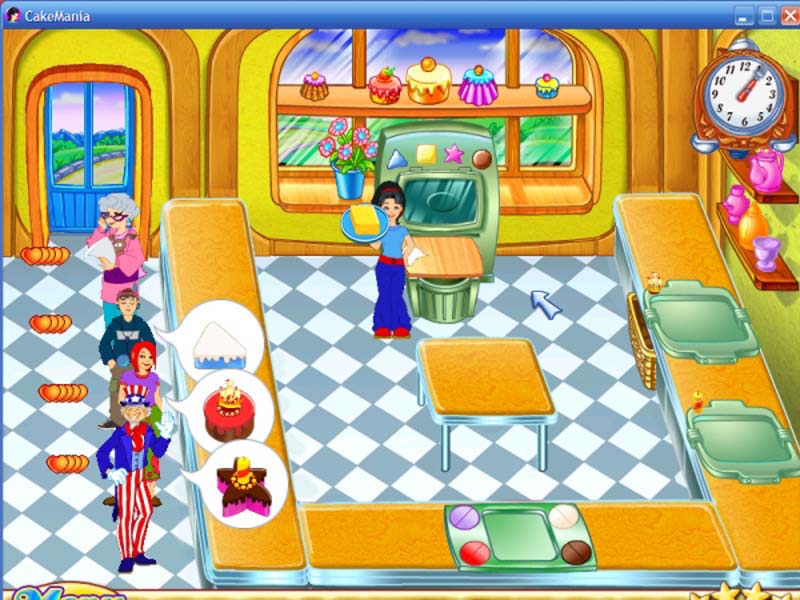 |
game still from Sandlot's Cake Mania, 2006
|
|
|
The material conditions of the ubiquitous apparatus of instant-image capture, process, and display, the material conditions of the this apparatus with which we, as a culture, are in a constant dialalogue, are integral to my work, as is said apparatus' influence on the directional development of visual culture. Low Lives 4 was a networked festival - in each of the over 40 participating venues, the audience would be viewing a live performance, preceded and followed by networked performances from around the world, transmitted via the internet and projected in the performance space. After the initial festival, all viewing would be online through the Low Lives archive. The audiences (online afterwards or 'in the venue' during the event) would take as a given the computer as a mediating factor in the presentation of the image. The computer screen, and to some extent the material conditions that bring the performance-video to it, would therefore be a variable in the presentation and reception of the piece. As an artist that considers and responds to the structural implications of the creation, transmission, and presentation of the work, the construction of an electronic, networked version of the performance piece would, for me, consider the limits of the technology to be a contributing factor in the determination of the delineated space, image, and content of the performance-video, an area for structualist concerns to germinate, and an area for these types of materialist concerns to inform and enhance other aspects of the work's content. |
| |
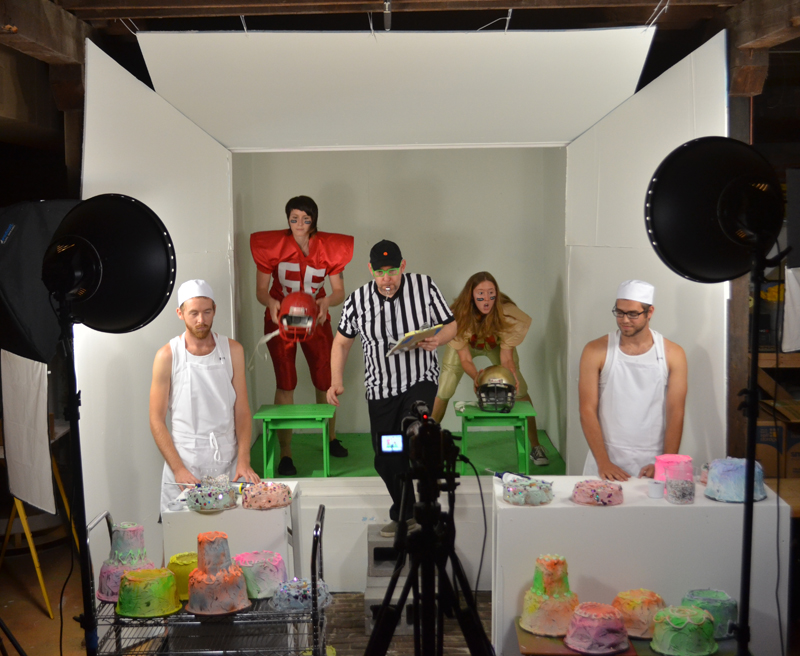 |
production still from the LL4 version of Infernal Cakes/Adjacent Manias
|
|
|
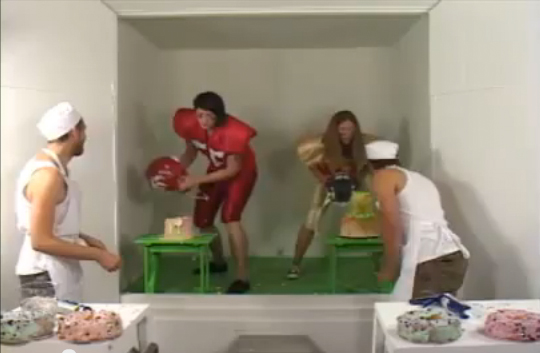 |
video still from the onscreen presentation of Infernal Cakes/Adjacent Manias for LL4 |
|
| |
|
|
|
Awareness of method-consequent video compression (by both USTREAM and YouTube) brings an intended medium specificity underlined by the title ( - reference both to the low res video game with its "early in the development of game technology" quality and the film from the early 1900s - with its "early in the development of film technology" quality).
Méliès' Infernal Cakewalk exhibits his usual 'for the stage' spatial composition - a tradtional, procenium based theatrical orientation re-presented on screen, compounded by the shallow space of the 'actually-on-stage' (pro-filmic) performance contributes to a very specific composition common to the classic Méliès image - a composition selected by Méliès not only due to technological constraints, but with artistic intention. By contrast, Lumière film at its earliest [think The Arrival of a Train at La Ciotat Station, 1895] used deep perspectival space in an attempt to replicate vision 'out in the world', also especially apparent in Lumière travel documentary - the deep space on lanscpe tableau from around the world often shot from a moving train. The shallow space in Méliès contributes directly to the actors' and props' appearance - that of seemingly dancing along the surface of the screen - the effect is of the represented elements activating, working with the surface of the display rather than denying it. (I am not arguing intention here, but rather affect, whether intended or not, and its contribution to the charm of the Méliès oeuvre, which cannot be denied)
A similar type of constructed space can be seen in early video game development, a space where flat characters dance along the surface of the screen, all activity taking place in an implied shallow space. Again, this space can be seen as intentional when juxtaposed with other early games from the same time, Atari's Tempest, 1981, and Star Wars, 1983, for instance, are games that were extremely concerned with working in perspectival space. The shallow space of Cake Mania, coming along in 2006, well along in the development of video game technology, can be seen as intentionally deploying this shallow space.
This is the space of Infernal Cakes/Adjacent Manias, LL4 version - thin, shallow, allowing actors and brightly colored props (30 painted plaster cakes per performance) to dance along the surface of the screen, highlighting the limitations of the medium while simultaneously taking advantage of them. |
| |
| |
| |
| INFERNAL CAKES/ADJACENT MANIAS (LL4 version) choreography: Red Devil's touchdown dance |
| The choreography of the Red Devil dance from Infernal Cakes is based completely on the devil dance from the Méliès film; the Red Devil dances the same dance as the Méliès devil in its entirety:a version of that historically controversial dance known as the cakewalk. |
| |
|
|
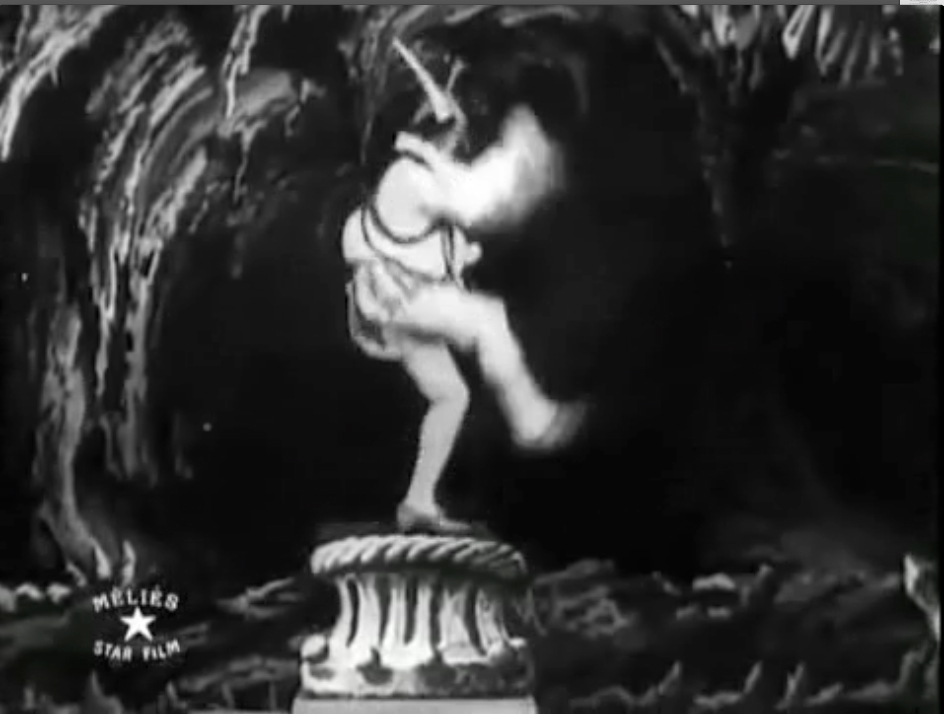 |
film still from George Méliès' Infernal Cakewalk, 1903
|
|
|
 |
video still from the onscreen presentation of Infernal Cakes/Adjacent Manias for LL4 |
|
| |
|
|
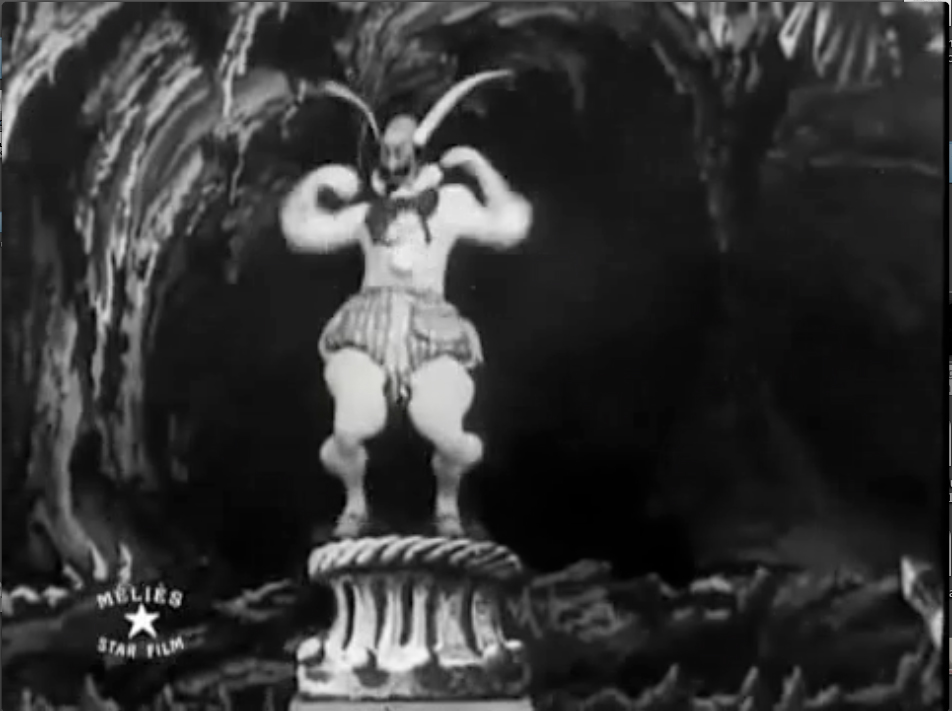 |
film still from George Méliès' Infernal Cakewalk, 1903
|
|
|
 |
video still from the onscreen presentation of Infernal Cakes/Adjacent Manias for LL4 |
|
| |
|
|
|
| |
| INFERNAL CAKES/ADJACENT MANIAS (LL4 version) choreography: Seminole touchdown dance |
| The Seminole touchdown dance is an amalgamation of several popular NFL touchdown dances taken from YouTube. |
| |
|
|
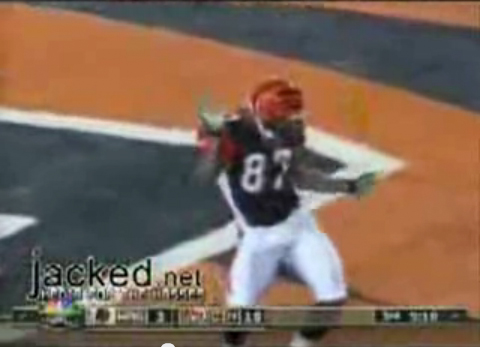 |
video still from youtube top 10 touchdown dance collage |
|
|
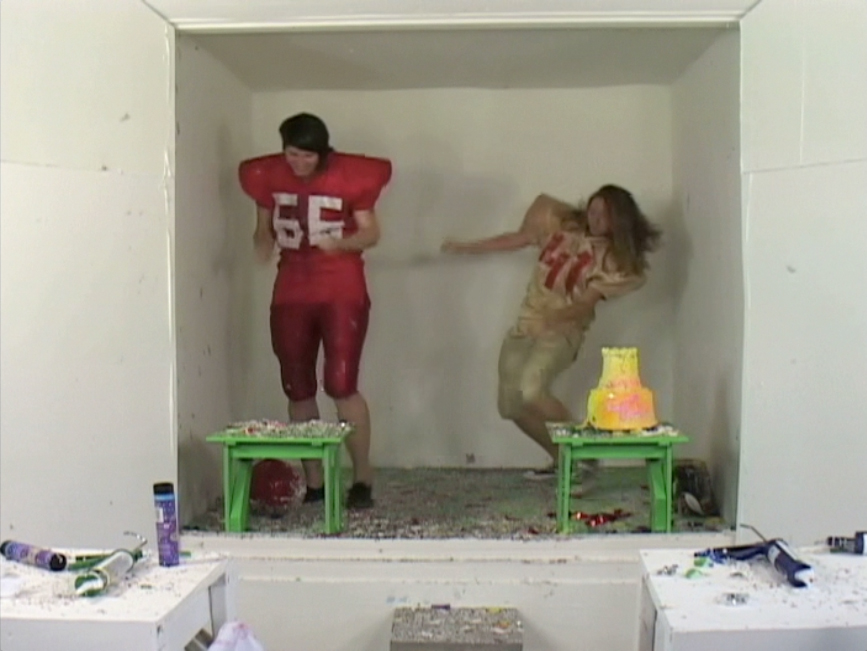 |
video still from the onscreen presentation of Infernal Cakes/Adjacent Manias for LL4 |
|
| |
|
|
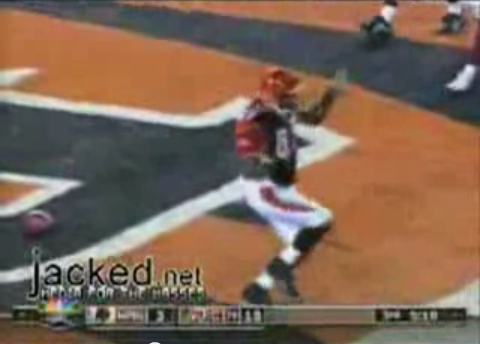 |
video still from youtube top 10 touchdown dance collage |
|
|
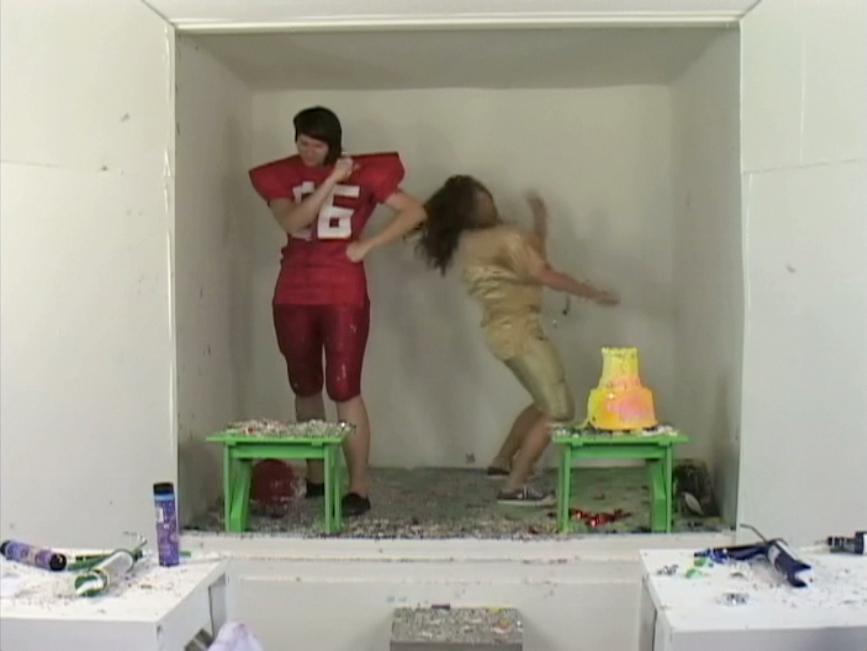 |
video still from the onscreen presentation of Infernal Cakes/Adjacent Manias for LL4 |
|
|
| |
| It was important to borrow the movements not only from pop culture, but from online 'viral' video as well - contemporary video memes that spread like a viruses, like infections, despite the attempts of the authoritative bodies to stop the spread, despite in the case of the NFL touchdown dance, the celebratory movement drawing penalties effecting not only the team and the play of the game (penalties leveed in the form of yardage lost) but for the individual outide of the field of play as well; exhorbitant fines for the actions, in the tens of thousands of dollars, are leveed against the perpetratror. Posited is the relationship between banned dances from the time of the early days of cinema and from now - dances banned for fear of infection and negative influence on contemporary youth. Indeed the cakewalk was the same type of dance, exploding in popularity in early 20th Century Paris, striking fear into the hearts of parents everywhere. |
| |
| INFERNAL CAKES/ADJACENT MANIAS (LL4 version): Red Devils vs. 'Noles |
| The choice of mascots was specific and intentional. The cakewalk has a contested origin, but what is not contested is that the dance was one done by the slaves in the antebellum south. |
| One supposition is that the dance originated on Florida plantations, inspired directly by Seminole dances that would have been seen by and participated in by (escaped) Florida slaves taking refuge with the native american Seminole tribes. Similarities in movement and tone have been described between the cakewalk and the Seminole dances. |
| The devil of course comes from the Méliès film, and it is significant that the cakewalks in the film, even those not performed by the devil, were performed in hell. The dance, with its African rhythms and unfamiliar movements, was seen as potentially dangerous to Parisian youth in its evocation of movements similar to those found in the Saint Vitus Dance, a historical european social phenomenon occurring primarily in Europe between the 14th and 17th centuries. The dancing mania involved large groups of people breaking out spontaneously into an erractic dance, a dance lasting sometimes for days, until the victims collapsed from exhaustion or even death. |
| |
INFERNAL CAKES/ADJACENT MANIAS (LL4 version):
LIFE, in an online archive OR
SKIMMING as our contemporary viewing condition |
| As stated earlier, the long term life of the piece will be its place in the Low Lives archive. An online archive creates a very specific and distracted viewing audience, one feeling the pressure of the vast amounts of material in that archive, as well as the infinite content available at a moments touch on the same machine used to acess that archive. With 200 other electronically adjacent performance-videos, a few seconds, at randomly selected intervasl throughout the piece, is the spectatorial condition of the piece's viewership: |
"Poet and UbuWeb (online video archive) founder Kenneth Goldsmith refers to the literary equivalent of [the rapid-fire skimming with which we browse news and reviews on our smartphones] as “the new illegibility”: books like his own Day (2003), a retyping of one day’s edition of the New York Times, which invites random sampling rather than straight-through reading. When online, he writes, “we parse text—a binary process of sorting language—more than we read it to comprehend all the information passing before our eyes.” Today, many exhibitions (by curators rather than artists) model this new illegibility as a spectatorial condition." Claire Bishop from Digital Divide, Artforum, Sept. 2012
|
| Taking the above described condition, as I do, as a given, begets a type of work more "movement-based" than time-based. Work like that of Méliès, work like that of a (watched) 80's video game (seen in the arcade, on your way to the open kiosk), work that moves along, that skims the surface of its own display, is work that allows for a spectatorship shorter in time that the duration of the piece, a work that functions in the skim, a work that functions in the time alotted ( the five minutes of the festival or the five seconds in the archive), a work that is perceived more like a moving photography, viewed as it teems pixels, on the viewers way to the next several. |
|











